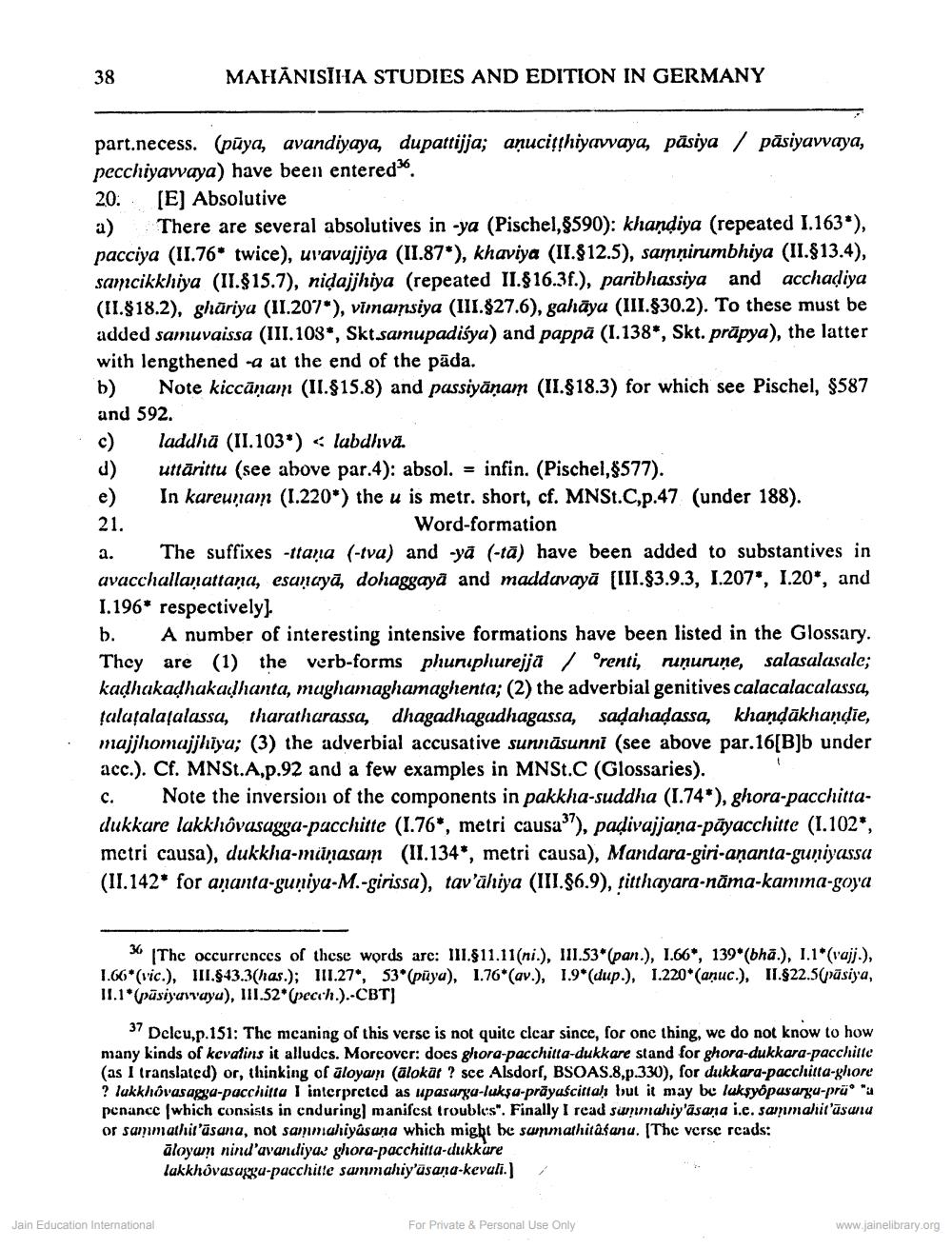________________
MAHĀNISĪHA STUDIES AND EDITION IN GERMANY
part.necess. (pūya, avandiyaya, dupattijja; anucithiyavvaya, päsiya / pāsiyavvaya, pecchiyavvaya) have been entered 20. [E] Absolutive a) There are several absolutives in -ya (Pischel, 8590): khandiya (repeated 1.163*), pacciya (11.76* twice), uravajjiya (II.87*), khaviya (II.812.5), samņinumbhiya (I1.813.4), samcikkhiya (II.$15.7), niqajjhiya (repeated II.816.3f.), paribhassiya and acchadiya (II.818.2), ghāriya (II.207*), vimansiya (III.927.6), gahāya (III.830.2). To these must be added samuvaissa (III. 103*, Skt.samupadiśya) and pappa (1.138*, Skt. prāpya), the latter with lengthened -a at the end of the päda. b) Note kiccānam (II. $15.8) and passiyānam (II.$18.3) for which see Pischel, $587 and 592. c) laddha (11.103*) <labdhiva.
uttārittu (see above par.4): absol. = infin. (Pischel,8577). e) In kareunam (1.220*) the u is metr. short, cf. MNSt.C,p.47 (under 188). 21.
Word-formation a. The suffixes -ttana (-tva) and yā (-tā) have been added to substantives in avacchallanattana, esanayā, dohaggaya and maddavayā (III.$3.9.3, 1.207", 1.20*, and I.196* respectively) b. A number of interesting intensive formations have been listed in the Glossary. They are (1) the verb-forms phuruphurejja / Prenti, nuņurune, salasalasale; kadhakadhakadhanta, mughamaghamaghenta; (2) the adverbial genitives calacalacalassa, talasalasalassa, tharatharassa, dhagadhagadhagassa, sadahadassa, khandākhandie, majjhomajjhiya; (3) the adverbial accusative sunnāsunni (see above par.16[B]b under acc.). Cf. MNSt.A,p.92 and a few examples in MNSt.C (Glossaries). c. Note the inversion of the components in pakkha-suddha (1.74*), ghora-pacchittadukkare lakkhôvasagga-pucchitte (1.76*, metri causa"), padivajjana-pāyacchitte (1.102*, metri causa), dukkha-miinasam (II.134*, metri causa), Mandara-giri-ananta-guniyassa (II.142* for ananta-guniya-M.-girissa), tav'āhiya (III.86.9), titthayara-nāma-kamma-goya
* The occurrences of these words are: 111.811.11(ni.), 111.53* (pan.), 1.66*, 139*(bhā.), 1.1*(vajj.), 1.66*(vic.), III.$43.3(has.); 111.27*, 53*(püya), 1.76*(av.), 1.9*(dup.), 1.220*(aņuc.), II.822.5(āsiya, 11. 1 ūsiyavvayu), III.52* (pech.).-CBT)
37 Delcu,p.151: The meaning of this verse is not quite clcar since, for one thing, we do not know to how many kinds of kevatins it alludes. Moreover: does ghora-pacchitta-dukkare stand for ghora-dukkara-pacchitte (as I translated) or, thinking of aloyan (alokar ? sce Alsdorf, BSOAS.8,p.330), for dukkara-pacchitta-ghore ? lakkhôvasagra-pacchita I interpreted as upasarga-luksa-prāyaściriah but it may be luksyopusargu-prü * penance (which consists in enduring) manifcst troubles". Finally I read sunmahiy'āsana i.e. sarmalit'ūsanu or sammathit'āsana, not sammahiyâsana which might be summathitâsanu. (The verse reads:
āloyan nind'avandiya' ghora-pacchitta-dukkure lakkhôvasagpu-pacchitle sammahiy'usana-kevali.)
Jain Education International
For Private & Personal Use Only
www.jainelibrary.org




